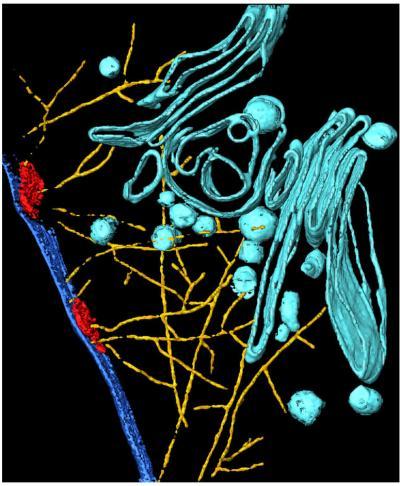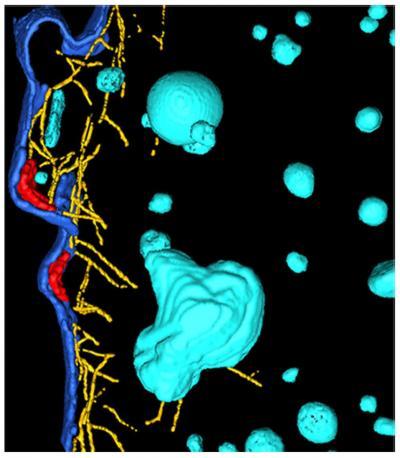Why do people with a hereditary mutation of the red blood pigment hemoglobin (as is the case with sickle-cell anemia prevalent in Africa) not contract severe malaria? Scientists in the group headed by Prof. Michael Lanzer of the Department of Infectious Diseases at Heidelberg University Hospital have now solved this mystery. A degradation product of the altered hemoglobin provides protection from severe malaria. Within the red blood cells infected by the malaria parasite, it blocks the establishment of a trafficking system used by the parasite's special adhesive proteins – adhesins – to access the exterior of the blood cells. As a result, the infected blood cells do not adhere to the vessel walls, as is usually the case for this type of malaria. This means that no dangerous circulatory disorders or neurological complications occur. The research study has been published in the journal Science, appearing initially online.
In the 1940s, researchers already discovered that sickle-cell anemia with its characteristic blood mutation was particularly prevalent in certain population groups in Africa. They also survived malaria tropica, whose course is usually especially virulent. With malaria tropica, the malaria parasites (Plasmodia) enter the person after a bite of an infected Anopheles mosquito. The mosquito first multiplies in the person's liver cells and then infects the red blood cells (erythrocytes). Once inside the erythrocytes, they divide again and ultimately destroy them. The nearly simultaneous bursting of all infected blood cells causes the characteristic symptoms, which include bouts of fever and anemia.
Adhesins on red blood cells cause circulatory disorders
In patients with malaria tropica, neurological complications such as paralysis, seizures, coma and severe brain damage also frequently occur. This is caused by an anomaly of the parasite Plasmodium falciparum. It forms special adhesins that reach the cell surface of the infected blood cell. Once there, it causes the erythrocytes to adhere to the vessel walls, preventing them from being recognized in the spleen as damaged and removed from circulation. The parasite's protective mechanism results in smaller vessels closing, becoming inflamed and for example, prevents parts of the nervous system from being adequately supplied with oxygen.

In red blood cells with normal hemoglobin, the malaria parasite Plasmodium falciparum establishes a trafficking system (yellow). The parasites proteins encased in transport envelopes (turquoise) use this system to directly access the cell surface of the red blood cell.
(Photo Credit: Photo: courtesy of Science/AAAS.)
In humans with mutated hemoglobin, these complications occur in a weakened form or not at all. "At the cell surface of infected erythrocytes with mutated hemoglobin, there are significantly fewer adhesins of the parasite than in normal red blood cells," explained Prof. Lanzer, Director of the Dept. of Infectious Diseases, Parasitology. "For this reason, we had a closer look at the trafficking system within the host cell." To this end, the team compared the blood cells with normal hemoglobin and two hemoglobin variants (hemoglobin S and hemoglobin C), which occur in around one-fifth of the African population in malaria-infected areas.
Trafficking system of the malaria parasite visualized for the first time
In so doing, the scientists used high-resolution microscopy techniques such as cryoelectron tomography to discover a new transport mechanism. The parasite uses a certain protein (actin) from the cytoskeleton (cellular skeleton) of the erythrocytes for its own trafficking network. "It forms a completely new structure that has nothing in common with the rest of the cytoskeleton," explained Dr. Marek Cyrklaff, group leader at the Dept. of Infectious Diseases, Parasitology and first author of the article. "The vesicles with the adhesins reach the cell surface of the red blood cells directly via these actin filaments."
In contrast to erythrocytes with the two hemoglobin variants, here only short pieces of actin filaments are found. Targeted transport to the surface is not possible. "The entire transport system of the malaria parasite is degenerated in these blood cells," Cyrklaff added. Laboratory tests showed that the hemoglobins themselves were not responsible for this, but rather a degradation product, ferryl hemoglobin. This is an irreversibly damaged, chemically altered hemoglobin that is no longer able to bind oxygen. The hemoglobins S and C are considerably more unstable than normal hemoglobin. As a result, blood cells with these variants contain ten times more ferryl hemoglobin than other erythrocytes. This high concentration destabilizes the binding of the actin structure and it disintegrates.
"With these results, we have now described a molecular mechanism for the first time that explains this hemoglobin variant's protective effect against malaria," Lanzer said.

In red blood cells with mutated hemoglobin variants, the trafficking system disassembles into short pieces (yellow). Targeted transport of proteins to the surface does not occur.
(Photo Credit: Photo: courtesy of Science/AAAS)
Source: University Hospital Heidelberg